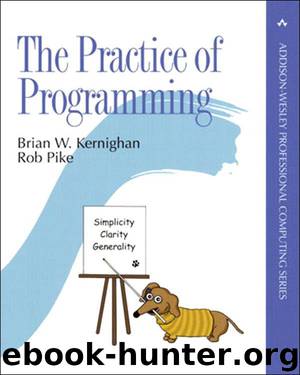The Practice of Programming (Addison-Wesley Professional Computing Series) by Brian W. Kernighan & Rob Pike

Author:Brian W. Kernighan & Rob Pike
Language: eng
Format: mobi
Publisher: Pearson Education
Published: 1999-02-08T21:00:00+00:00
5.8. Summary
With the right attitude debugging can be fun, like solving a puzzle, but whether we enjoy it or not, debugging is an art that we will practice regularly. Still, it would be nice if bugs didn’t happen, so we try to avoid them by writing code well in the first place. Well-written code has fewer bugs to begin with and those that remain are easier to find.
Once a bug has been seen, the first thing to do is to think hard about the clues it presents. How could it have come about? Is it something familiar? Was something just changed in the program? Is there something special about the input data that provoked it? A few well-chosen test cases and a few print statements in the code may be enough.
If there aren’t good clues, hard thinking is still the best first step, to be followed by systematic attempts to narrow down the location of the problem. One step is cutting down the input data to make a small input that fails; another is cutting out code to eliminate regions that can’t be related. It’s possible to insert checking code that gets turned on only after the program has executed some number of steps, again to try to localize the problem. All of these are instances of a general strategy, divide and conquer, which is as effective in debugging as it is in politics and war.
Use other aids as well. Explaining your code to someone else (even a teddy bear) is wonderfully effective. Use a debugger to get a stack trace. Use some of the commercial tools that check for memory leaks, array bounds violations, suspect code, and the like. Step through your program when it has become clear that you have the wrong mental picture of how the code works.
Know yourself, and the kinds of errors you make. Once you have found and fixed a bug, make sure that you eliminate other bugs that might be similar. Think about what happened so you can avoid making that kind of mistake again.
Download
This site does not store any files on its server. We only index and link to content provided by other sites. Please contact the content providers to delete copyright contents if any and email us, we'll remove relevant links or contents immediately.
The Mikado Method by Ola Ellnestam Daniel Brolund(20603)
Hello! Python by Anthony Briggs(19899)
Secrets of the JavaScript Ninja by John Resig Bear Bibeault(18208)
Dependency Injection in .NET by Mark Seemann(18108)
The Well-Grounded Java Developer by Benjamin J. Evans Martijn Verburg(17575)
OCA Java SE 8 Programmer I Certification Guide by Mala Gupta(17421)
Kotlin in Action by Dmitry Jemerov(17185)
Adobe Camera Raw For Digital Photographers Only by Rob Sheppard(16930)
Algorithms of the Intelligent Web by Haralambos Marmanis;Dmitry Babenko(16235)
Grails in Action by Glen Smith Peter Ledbrook(15390)
Test-Driven iOS Development with Swift 4 by Dominik Hauser(10393)
Becoming a Dynamics 365 Finance and Supply Chain Solution Architect by Brent Dawson(8055)
Microservices with Go by Alexander Shuiskov(7819)
Practical Design Patterns for Java Developers by Miroslav Wengner(7719)
Test Automation Engineering Handbook by Manikandan Sambamurthy(7671)
Angular Projects - Third Edition by Aristeidis Bampakos(7159)
The Art of Crafting User Stories by The Art of Crafting User Stories(6611)
NetSuite for Consultants - Second Edition by Peter Ries(6533)
Demystifying Cryptography with OpenSSL 3.0 by Alexei Khlebnikov(6305)
